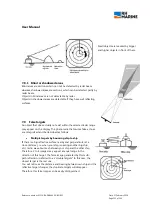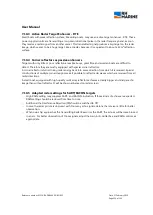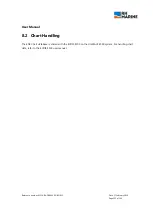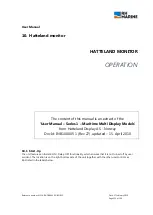
User Manual
Reference number: 4111A-RADAR4600-GBD-R1.1
Date: 27 February 2018
Page 127 of 149
7.11
Damping effects by precipitation
Precipitation is the general term used to describe various states in which water can manifest itself in the
atmosphere. Examples are rain, snow and hail. Reflections from precipitation can produce unwanted echoes
on the screen, which is commonly named as ‘Rain clutter’. It is displayed similar to 'Sea clutter', but it has
other characteristics which are quite different.
Simplest form to explain are big rain drops. They are like a mass of very little balls, reflecting the radar
impulses in multiple directions. Only a little part is reflected back to the radar antenna and is indicated
similar like sea clutter.
The significant effect in contrast to sea clutter is, that the detection of weak or little targets within the
precipitation area and also perpendicular to radar antenna behind of this area is reduced. Following tables
show the reducing of target detection in relation to rain volume and to different pulse length.
Reduction of range to first detection due to rain at X-band
Reduction of range to first detection due to rain at S-band
Generally a selection of S-band radar and short pulse length will increase the possibility of target
discrimination within a precipitation area.
The detection of targets beyond a precipitation area also will be improved by selecting S-band radar, but in
those cases the results will be better, when selecting a longer pulse length.
















































